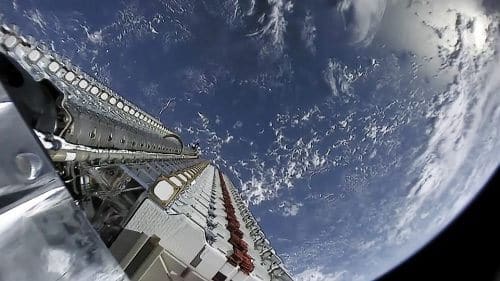"Wow, it worked", wrote the entrepreneur and billionaire on the Twitter account, which is connected through the advanced media ● Despite the success, Starlink satellites made by Space-X will not be really active until tens of thousands of them reach space

A tiny cluster of Starlink satellites launched into space by SpaceX already provides a "boutique service" for internet connection from tiny low-orbit satellites, according to Elon Musk, CEO and founder of the company.
Last Monday, late at night - as is his holy habit, being a fan of using Twitter to communicate with his followers - the original entrepreneur and billionaire, who is also behind other companies such as the electric car manufacturer Tesla, tweeted. Musk informed the world that he is trying to publish something using Starlink, the company's satellites that are supposed to provide the inhabitants of the world with broadband connectivity, and that Space-X began assembling this year. "Sending this tweet from space via the Starlink satellite", Musk posted and two minutes later tweeted again and wrote: "Wow, it worked!!"
The Starlink and SpaceX satellite array is still in the making, and the future vision regarding it is still far from being realized. SpaceX has so far received approval to launch about 12,000 Starlink satellites, and recently applied for permission to add another 30,000 to it. However, the company has so far launched and put into operation only 60 satellites, which were flown into space last May on the company's Falcon 9 rocket.
Whoa, it worked!!
- Elon Musk (@elonmusk) October 22, 2019
At the time, at the time of the launch, Musk prepared the world that there would likely be mistakes in the initial deployment, and that it would take at least six more similar launches to achieve "minor" broadband coverage, and double that to reach "moderate" coverage, as quoted by Engadget. It should be noted that in order to provide Internet connectivity, these satellites are supposed to move in space in synchronized motion and transmit the signals to the ground terminals on Earth. According to what can be understood now, despite the success of the CEO's little experiment, several more launches will be required before we can all enjoy the innovation of the Starlink project.
However, SpaceX is not the only company with plans to offer Internet via satellites - Amazon aims to launch more than 3,000 low-orbit broadband communications satellites in the future, and satellite startup One-Web has launched its first six satellites, out of a planned 650. for the mission, earlier this year.
When they operate on the ideal and extensive scale, these networks will fundamentally change the communication situation of the population on earth and will provide connectivity to every remote corner of the world. Today, only about 2,000 operational satellites orbit our planet, and less than 9,000 have been launched since the beginning of the space age in 1957.
Some astronomers have expressed concern that the upcoming broadband satellites will affect their observation of cosmic objects. Other space stakeholders have emphasized that we must think carefully about ways to mitigate the potential junk threat inherent in these initiatives, and in the many small satellites that are now ascending into space thanks to the dramatic drop in the cost of access to it.
It is worth mentioning that Musk, who even flew a red Tesla car into space to show the world how much things are possible today - as well as his competitor Jeff Bezos, CEO and founder of Amazon - has the pretense of colonizing Mars in the near future, so the invasion of space by satellites is only the beginning the road.
More of the topic in Hayadan:
